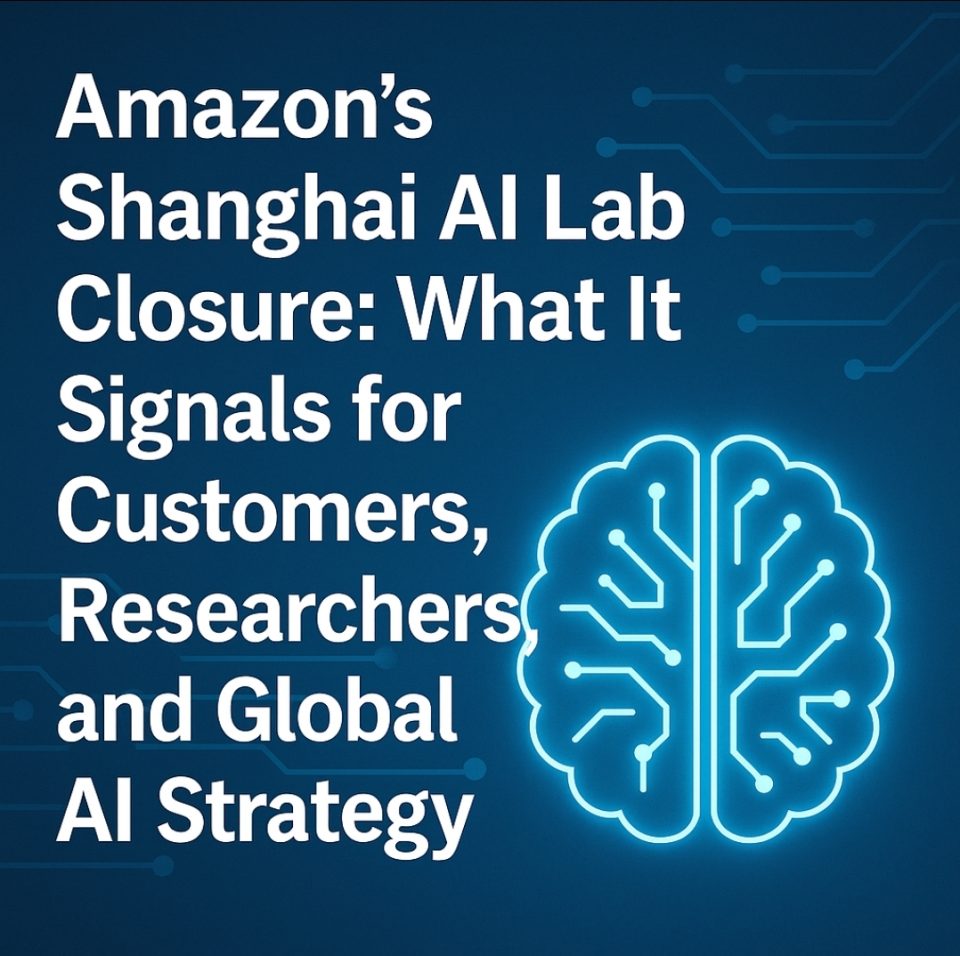Amazon’s Shanghai AI Lab Closure: What It Signals for Customers, Researchers, and Global AI Strategy
Amazon is packing up its Shanghai AI research lab after seven years. The surprise move, reported by The Financial Times and later confirmed by Amazon, leaves partners, researchers, and customers asking one big question: what’s next?
A swift recap
The AWS Shanghai AI Lablet opened in 2018 with big goals. It aimed to tap China’s deep AI talent pool and advance graph neural networks. The team:
- Published over one hundred peer-reviewed papers on graph learning and related topics.
- Built the acclaimed Deep Graph Library (DGL), now integrated with Amazon SageMaker.
- Helped drive about one billion dollars in AWS-linked revenue, according to an internal estimate shared by a senior scientist.
Yet, in late July 2025, applied scientist Wang Minjie told colleagues on WeChat that the lab was “being dissolved due to strategic adjustments amid US-China tensions.”
Amazon later confirmed the shutdown, describing it as part of a broader re-prioritization and stating that around a dozen employees were impacted.
Why did Amazon pull the plug?
1. Escalating geopolitics
Washington has tightened export rules on advanced chips and cloud access. Beijing has responded with stricter data-transfer policies. This two-sided squeeze makes cross-border AI collaboration messy and risky.
2. Cost-cutting and focus
AWS is trimming staff in marketing, training, and research teams. Executives say the company must “optimize resources to deliver innovation.” The Shanghai lab, while influential, sat outside Amazon’s main engineering hubs.
3. Rising compliance overhead
Running R&D in China now requires navigating export licenses, security reviews, and local partner checks. Amazon chose to concentrate on markets with clearer regulatory paths.
What happens to the tech?
The star output, DGL, remains open source on GitHub and available via SageMaker containers. Users can still train graph models at scale, but future feature upgrades will likely stem from teams in the US, Europe, or India.
Customer experience: immediate effects
- Chinese enterprises on AWS China Region
Day-to-day cloud services stay online. The lab focused on core research, not regional operations. However, local customers may lose early access to bleeding-edge graph tools and on-site expert workshops. - Global AWS customers
The main DGL roadmap continues. But new releases could slow as Amazon redistributes work. Managed services like Neptune ML and SageMaker DGL should stay stable. - Developers who relied on Shanghai researchers
Community pull-requests may face longer review cycles. Amazon promises continuity, yet users should watch project forums for maintainer updates.
Talent ripple effects
Shanghai-based scientists now weigh three routes:
- Relocate to other Amazon hubs.
- Join Chinese tech giants eager to fill the gap.
- Move to universities or startups that snap up graph-learning expertise.
The brain drain could widen the research gulf between Chinese and Western AI communities.
Competitive landscape: who benefits?
- Baidu, Alibaba, and Tencent can hire top researchers without relocation hurdles.
- Nvidia and AMD may sell more on-premise hardware to Chinese firms now leaning on domestic AI pipelines.
- Microsoft and IBM, which already scaled back China R&D, appear vindicated in their cautious stance.
Strategic signals for enterprise customers
- Assess geopolitical exposure
Firms building AI around US–China data flows face growing friction. Map out model-training locations and chip supply chains. - Diversify AI partners
Relying on a single vendor’s overseas research hub can backfire. Blend open-source libraries, regional cloud options, and in-house capabilities. - Watch for fragmented standards
As US and China fortify separate ecosystems, interoperability—from model checkpoints to data formats—may erode. Plan for translation layers and dual-stack tooling.
Gradual shift to deeper analysis
The closure of Shanghai AI Lab is more than a cost trim. It highlights digital decoupling—a macro trend where global tech splits along political lines. Research once spread across continents now clusters in “friendly” jurisdictions.
Graph neural networks illustrate the stakes. DGL sped up drug-discovery pipelines, fraud detection, and recommendation engines. When labs like Shanghai’s go dark, the flow of fresh ideas into open ecosystems slows.
From a customer-experience lens, fewer cross-border innovations may narrow the service menu that AWS rolls out worldwide. Over time, enterprise buyers could face divergent feature sets: some tuned for Western compliance, others for Chinese regulations.

Looking forward
Amazon says it will keep investing in AI “having the greatest impact.” Analysts expect deeper bets in:
- Bedrock-powered generative AI services.
- India-based applied-science hubs, where Amazon just expanded hiring.
- Sustainability-focused ML, aligned with corporate climate goals.
For now, though, one of Amazon’s most celebrated overseas labs is history.
Key takeaways
- Expect continued cloud reliability, but slower live-from-lab breakthroughs.
- Plan for geopolitical turbulence in AI roadmaps.
- Diversify research and partner footprints to stay resilient.
Change happens fast in tech. Yet customers armed with flexible architectures, solid governance, and a watchful eye on policy shifts can still thrive—even as giants like Amazon redraw their innovation maps.

